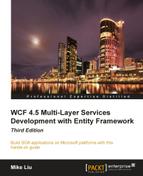WCF is Microsoft's recommended model for building services and Entity Framework is Microsoft's preferred ORM for accessing underlying data storages. Learning WCF and Entity Framework has become essential and critical for every software developer to survive in this SOA world.
This book is a step-by-step tutorial to guide you through learning WCF, Entity Framework, LINQ, and LINQ to Entities. You will be guided to create five WCF and Entity Framework solutions, of which three are multi-layered real-world WCF service solutions, so you will not only be reading, but also be coding through the book, to gain practical experience of WCF and Entity Framework. Various test clients will be associated with each solution and all solutions can be built and run independently of other solutions. Clear instructions and relevant screenshots will make sure you won't get lost in the world of WCF and Entity Framework. Configuration files, host applications, test clients, and WCF services for each solution will also be available to download for you to examine, modify, and debug from the outside in.
This book focuses on the essentials of using WCF and Entity Framework, rather than providing a reference to every single possibility. It leaves the reference material online where it belongs, and concentrates instead on practical examples, code, and advice.
Chapter 1, Web Services and Windows Communication Foundation, covers basic concepts of web services and WCF.
Chapter 2, Implementing a Basic HelloWorld WCF Service, discusses how a simple HelloWorld WCF service is implemented, hosted, and consumed.
Chapter 3, Hosting and Debugging the HelloWorld WCF Service, discusses various hosting and debugging techniques of WCF services.
Chapter 4, Implementing a WCF Service in the Real World, explains how to create a layered WCF service with an interface layer and a business logic layer.
Chapter 5, Adding Database Support and Exception Handling, explains how to add a data access layer and fault message handling to the previously created WCF service.
Chapter 6, LINQ: Language Integrated Query, discusses LINQ-related language features such as anonymous types, extension methods, and lambda expressions.
Chapter 7, LINQ to Entities: Basic Concepts and Features, covers the basic concepts and features of LINQ to Entities such as LINQ to Entities designer, querying and updating tables, deferred execution, and lazy/eager loading.
Chapter 8, LINQ to Entities: Advanced Concepts and Features, covers advanced concepts and features of LINQ to Entities such as stored procedure, inheritance, concurrency control, and transaction support.
Chapter 9, Applying LINQ to Entities to a WCF Service, discusses how to recreate the data access layer of a WCF service with LINQ to Entities.
Chapter 10, Distributed Transaction Support of WCF, explains how to add distributed transaction support to a WCF service.
Chapter 11, WCF Security, covers basic security features and settings of WCF, and hosts a WCF service with Basic Authentication, SSL, and Windows Authentication.
Chapter 12, Extending WCF Services, explains various extension points of WCF services and extends a WCF service with custom behaviors.
